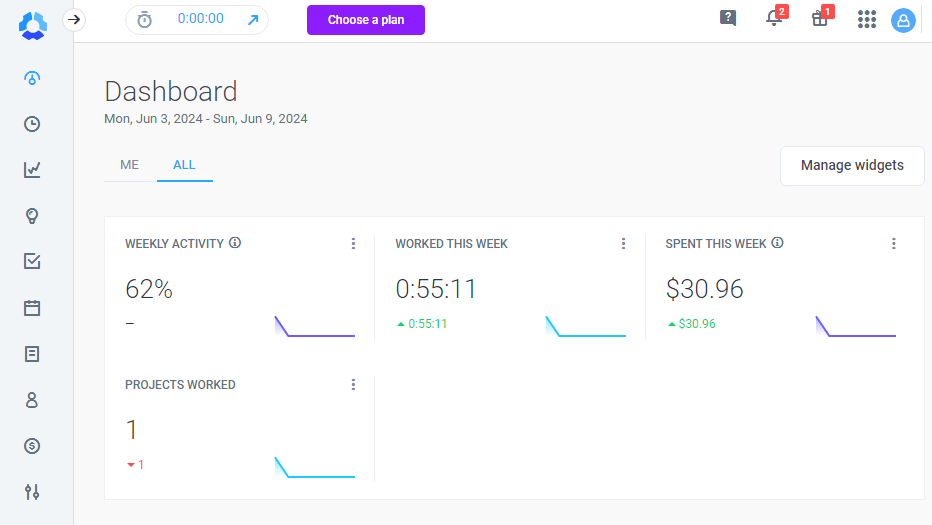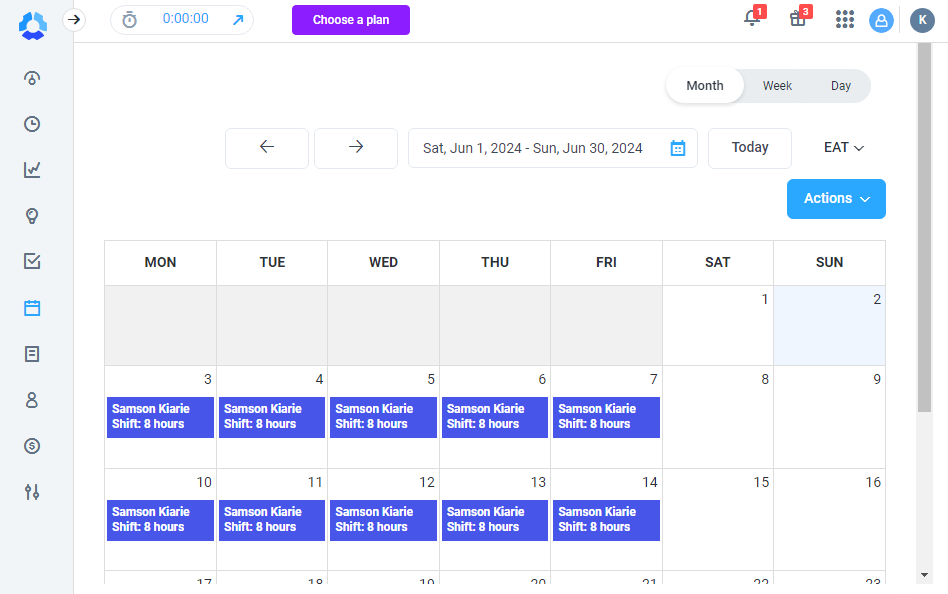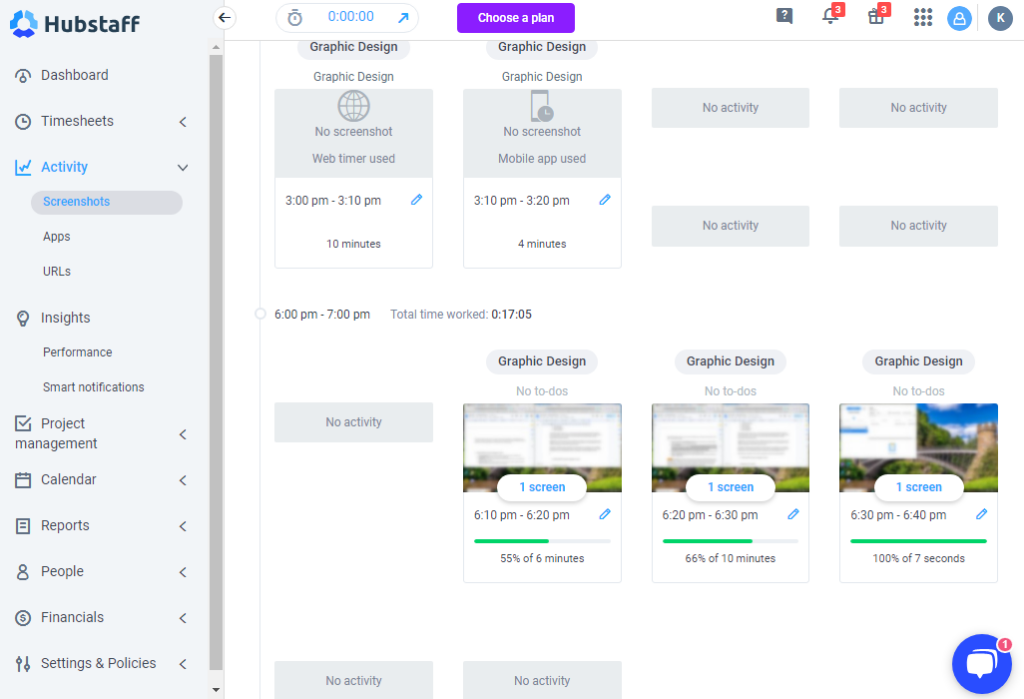Connecteam and Hubstaff are two popular and feature-packed workforce management solutions. While they share many similarities, some of their features cater to distinct operational needs, making each platform a better fit for different types of businesses.
Choosing the right app could mean the difference between wasting money on unused features and solving your specific pain points.
In this Connecteam vs Hubstaff guide, I’ll compare the two apps side by side to help you make an informed decision. Keep reading for all the details.
Note: I have been using Connecteam for over a year now, and have rigorously tested Hubstaff in real-world scenarios. As a result, this Hubstaff vs Connecteam comparison is based on my real, hands-on experience.
At a Glance: Quick Summary
Connecteam and Hubstaff are two of the best workforce management solutions on the market today. While some of their capabilities overlap, they also have subtle differences that gear them towards different user bases.
Connecteam is tailored for non-office workforces, like those in construction, manufacturing, hospitality, healthcare, retail, field service, and other field-based industries. It’s helpful for businesses that want to schedule employees, track time, and monitor field activities in full compliance with labor laws.
Hubstaff, on the other hand, is built primarily for deskbound employees in in-office, remote, and hybrid setups. While it offers time tracking, scheduling, and location tracking features, it’s best known for its desktop monitoring and productivity measurement tools. Read our full Hubstaff review to learn more.
Pricing and Plans
| Connecteam Ops Hub | Hubstaff* |
Free plan
| ❌ |
| Basic $29/month for up to 30 users** and $0.80 for each additional user
| Starter $4.99/user/month
|
| Advanced $49/month for up to 30 users and $2.5 for each additional user Everything in Basic, plus
| Grow $7.50/user Two seats minimum Everything in Starter, plus:
|
| Expert $99/month for up to 30 users and $4.2 for each additional user Everything in Advanced, plus:
| Team $10/user/monthTwo seats minimum Everything in Grow, plus:
|
| Enterprise Custom pricing Everything in Expert, plus:
| Enterprise $25/user/month Everything in Team, plus:
|
| * All prices show the monthly cost when billed annually as of November 2025.** That’s $0.96/user/month if you take advantage of all 30 users in the plan. | |
Connecteam and Hubstaff have very different pricing models. Hubstaff uses a seat-based approach, with a minimum of two seats for most pricing tiers. Connecteam offers a flat rate for the first 30 users, with additional seats available as your team expands.
Another difference is that Hubstaff bundles its advanced features in the highest-tier plans. Good examples are scheduling, overtime and breaks, and compliance tools, which are only available on Hubstaff’s Teams and Enterprise plans. What’s more, vital features such as location and geofence are paid add-ons, which may put them out of reach for businesses on tight budgets.
Connecteam takes a more flexible approach by dividing its tools into three “Hubs”: Operations, Communication, and HR & Skills. This modular setup lets you customize the platform and pay only for the advanced functionality you actually need.
Note: This pricing comparison focuses on Connecteam’s Operations Hub because it includes most of the core features that overlap with Hubstaff, such as time tracking, scheduling, and GPS tracking.
Connecteam also offers a generous free plan for businesses with up to 10 users. The free plan gives small businesses access to all premium features, with some minor usage limits. Hubstaff, by contrast, doesn’t offer a free plan.
Overall, Connecteam offers better value for money. The basic plan gives you access to the essential features most businesses need. As you move to higher-tier plans, you unlock higher usage limits and advanced automation tools that help you save time as your business grows. This structure makes Connecteam a cost-effective solution for businesses of any size.
Pros and Cons
These pros and cons highlight where both Connecteam and Hubstaff shine, and where they might fall short.
Connecteam Pros ✅
- Advanced overtime and break controls
- Automated scheduling capabilities
Connecteam Cons ❌
- Lacks productivity measurement tools
- Steeper learning curve due to its feature-richness
Hubstaff Pros ✅
- Desktop activity monitoring
- Productivity measurement tools
Hubstaff Cons ❌
- Lacks advanced overtime and break controls
- Lacks kiosk mode
Use Cases
While Connecteam and Hubstaff share core features, each has unique capabilities that suit different use cases:
Connecteam is best for:
- Accurate time tracking: Connecteam helps you precisely track employees’ work hours for accurate wage payments. You can use tools like geofencing, overtime and break trackers, and facial recognition-based punching in/out to prevent time theft and ensure timesheets are accurate and compliant.
- Employee onboarding and training: Connecteam’s mobile-first approach lets new hires access onboarding resources directly from their smartphones. It also makes training accessible anytime, anywhere, streamlining the learning process for your employees on the go.
Hubstaff is best for:
- Billable time tracking: Hubstaff automatically clocks employees in and out as they enter and leave a geofenced site. This helps accurately track the time an employee spends at a customer’s address.
- Desktop activity monitoring: Hubstaff supports screenshot recording, app and website tracking, and idle time detection. These features make it ideal for employers who need to monitor productivity and foster accountability across office, remote, and hybrid teams.
Side-by-Side Feature Overview
Connecteam and Hubstaff are powerful workforce management solutions, with some differences that could sway your purchasing decision. In this section, I’ll walk you through the similarities and differences between the two apps on key fronts. Keep reading for all the details:
Usability and interface — Winner: Tie
Both Connecteam and Hubstaff are user-friendly and well-designed. Both are convenient and simple to use on the desktop, but Connecteam definitely takes the lead when it comes to its mobile app.
Connecteam is designed for ease of use in the field and has powerful yet user-friendly mobile apps for Android and iOS smartphones. The intuitive app lets deskless employees, including the technologically inexperienced, track time, view schedules, and complete tasks in the field with ease.

The web interface is so feature-rich that some users might find it a little overwhelming at first. However, once you get the hang of the various hubs, everything starts to fall into place, and navigating the app becomes much easier. I have also found the ability to customize the navigation panel helpful in easing the learning curve.
Hubstaff, on the other hand, is clearly designed for desktop use. Its web and desktop apps pack a wide variety of features, and its UI is well-organized and simple to navigate. The mobile app is a different matter, with a more trimmed-down feature set. With a heavy focus on beginner-friendly design, it’s very easy to use but lacks many features that are indispensable for field staff.
Time tracking — Winner: Connecteam
Connecteam and Hubstaff come with feature-rich time tracking tools that let you track your employees’ regular hours, overtime, and breaks. But their similarities end there. After thorough examination and hands-on testing, I found that their time trackers differ in depth and nature.
Connecteam lets employees clock in/out via web, mobile, and kiosk apps, making Connecteam ideal for on-site workplaces where employees don’t have individual devices.
Better yet, Connecteam helps businesses with non-exempt employees to comply with labor laws and internal policies. It helps track all types of overtime, including advanced cases like daily double-time and 7th-consecutive-day overtime. Additionally, the break tracker has advanced controls such as reminders and the ability to prevent early returns.
Hubstaff, by contrast, lets employees track time on web, desktop, and mobile apps. It doesn’t come with a kiosk app, and its overtime and break time trackers have no advanced controls. I think the kiosk mode would have been a helpful addition for office-based environments where mobile phones are a distraction.
Its desktop app tracks and attributes time to specific tasks. It also lets you determine how much time employees spend on various apps and websites. You can also use Hubstaff to track billable time for field technicians, thanks to its flexible geofence feature.
Geofencing — Winner: Connecteam
A geofence is virtual boundary set around a physical location, like a remote job site. When you set a geofence, apps like Connecteam can see if workers enter or leave the area, helping you know whether workers are where they should be.
Connecteam’s geofence feature is available on all plans, but the number of geofence sites you can create varies. In comparison, Hubstaff’s geofence feature isn’t available on the Starter and Grow plans. You can only buy it as an add-on if you’re on the Teams plan, but it’s included in the Enterprise plan.

Connecteam’s geofence lets you implement advanced restrictions and controls, like preventing employees from clocking in outside the designated job site. This prevents off-site punching, ensuring that each employee is paid only for the time spent on the actual job.
Better yet, Connecteam can automatically clock out employees when they leave a geofence and immediately alert you. This feature is especially useful when you need to make sure employees stay at their job sites. For example, you can use it to ensure guards are always at designated sites, improving accountability and reducing liability.
Hubstaff keeps things simple. By default, it automatically clocks employees in or out when they enter or leave the geofenced site. This is especially helpful when you want to track billable hours in a field service or client-based environment. Alternatively, you can set up the geofence to prompt employees to clock in or out as they enter or leave the area.
Location tracking — Winner: Connecteam
Connecteam and Hubstaff both come with GPS location tracking capabilities. But, since Connecteam is geared more towards field and mobile teams, its features are more advanced.
Connecteam updates your employees’ locations every few minutes, allowing you to monitor their field activity in real-time. No more guessing if your security guards are in the right patrol zone or if the technician made it to the assigned address. Simply zoom in on any employee on the map to see where they are from the comfort of your office (or while on the go).
Even better, Connecteam uses breadcrumb technology to help you determine an employee’s route and know exactly when they were at certain locations. I find this level of detail indispensable for industries where accountability and pinpoint location accuracy are crucial.
Hubstaff tracks employee location in real-time, but the feature is available only as a paid add-on on some plans. I liked that it shows the route an employee takes while on the clock.Unfortunately, you can’t verify when exactly field employees were at specific locations.
Employee scheduling — Winner: Connecteam
Having used both apps, I can confidently say that Connecteam is better suited for scheduling in fast-paced environments. Before you start creating shifts, Connecteam lets you define schedule rules and policies for compliance with labor laws and industry-specific regulations. For example, you can stipulate the maximum hours, maximum shifts, and even the mandatory rest period between shifts.
Once you’ve laid the groundwork, creating schedules is a breeze with tools like drag-and-drop functionality, shift templates, shift copying, and recurring shifts. I especially liked Connecteam’s auto-scheduler, which eliminates manual work, allowing you to assign hundreds of shifts in just a few clicks based on your employees’ availability and qualifications.
Hubstaff scheduling, by contrast, is trimmed down to the basics and might not be effective for shift-oriented teams. It lacks the vital tools I have come to expect of the best scheduling software, such as drag-and-drop functionality, an automatic conflict detector, and schedule views.

Hubstaff also lacks employee self-service tools like shift swaps, covers, and drops. The missing features make Hubstaff better-suited for teams that need basic, no-frills shift planning.
Paid time off (PTO) management — Winner: Connecteam
Both Connecteam and Hubstaff support fixed and accrual paid time-off models. They let you add multiple leave types to match internal policies and labor laws. You can also set accrual rules, limit carryover balances, and choose whether to allow negative balances. Employees can request time off on mobile devices, making both apps suitable for on-the-go teams.
Beyond these similarities, Connecteam has unique features that make it a great fit for dynamic industries with seasonal spikes. It lets you set blackout days to restrict time-off on specific days, like peak periods when you need all hands on deck. You can also stipulate a minimum notice for each request so that you get enough time to adjust schedules.
Hubstaff doesn’t support blackout days or minimum leave notice, so keep that in mind if you need more control over PTO requests. However, the software is still effective for project-based teams that don’t usually experience fluctuating labor demands.
Integrations — Winner: Hubstaff
Based purely on the number of native integrations, Hubstaff has the leg up on Connecteam. It integrates with over 30 third-party software, including payroll, project management, help desk, CRM, and invoicing platforms. Connecteam, by contrast, integrates with 7+ third-party software, including ADP, QuickBooks Online, Gusto, Xero, and Paychex.
In addition to these native integrations, both apps support Zapier workflows. The Zapier integration lets you connect either Connecteam or Hubstaff with hundreds of apps without coding skills. As a result, it’s easy to implement even without any technical know-how. I have found Zapier integrations helpful for businesses that rely on a diverse technology stack.
Moreover, Connecteam and Hubstaff support Application Programming Interface (API) integrations to streamline data flow between tools. However, Connecteam has the upper hand as it offers a broader range of APIs for Jobs, Forms, and Scheduler. Hubstaff, on the other hand, has limited extensibility as it provides a time tracking API only.
Activity monitoring — Winner: Hubstaff
Hubstaff supports desktop activity monitoring, making it ideal for business owners who need visibility into employees’ daily activity. It captures screenshots and tracks the applications and websites the employee visits while on the clock. This gives you insights into how employees spend their workday, and it can help foster accountability.

My favorite Hubstaff feature is smart notifications, which help pinpoint overworking, underworking, and other unusual activity levels. The insights help break down individual employee performance to enhance overall productivity. They also help unearth and remedy patterns that can spiral into burnout, thereby boosting employee well-being.
Connecteam, by contrast, doesn’t monitor desktop activity, and that’s by design, not oversight. The app is built primarily for deskless teams that spend most of their time in the field rather than behind a desk. As a result, the desktop activity monitoring feature is unnecessary for the users it’s built for.
User Ratings
The impressive overall scores on popular review sites reflect how satisfied customers are with both Connecteam and Hubstaff. I combed through these individual reviews and found glowing comments regarding the various aspects of these apps.
Connecteam
- ⭐ 4.6/5 on Capterra
- ⭐ 4.6/5 on G2
Hubstaff
- ⭐ 4.6/5 on Capterra
- ⭐4.5/5 on G2
Security & Compliance
| Category | Connecteam | Hubstaff |
| Data Encryption | ✅ | ✅ |
| GDPR Compliant | ✅ | ✅ |
| HIPAA Compliant | ✅ | ✅ |
| SOC 2 Type 2 Compliant | ✅ | ✅ |
| 2FA | ✅ | ✅ |
| Hosting Region | US/EU/Australia/Asia | US/EU |
Connecteam and Hubstaff take data security seriously. The fact that neither has ever had a data breach or major security incident demonstrates their rigid security stance.
Both platforms use AES 256-bit encryption to protect both stored and transmitted data. AES 256-bit encryption is regarded as one of the most secure ciphers, impossible to break with current technology. You can rest assured that data exchanged on both apps is secure and out of reach of unauthorized users.
Moreover, they secure users’ accounts with 2FA: two-factor authentication. 2FA adds an extra layer of protection that prevents unauthorized access. Both are also SOC 2 Type 2 compliant, meaning that they have strong data security controls in place. I also found that the apps handle data in strict adherence to industry and local regulations like the GDPR and HIPAA.
Setup and Onboarding
More often than not, feature-rich software takes time to set up due to the sheer number of available features. Thankfully, setting up Connecteam and Hubstaff felt straightforward.

I liked Hubstaff’s guided setup process. With it, I was able to set up everything I needed without having to switch between numerous tabs. This saved me a lot of manual hassle and allowed me to get my team up and running in minutes, not hours.
Likewise, setting up Connecteam was pretty straightforward. But, instead of a guided setup, Connecteam offered a quick setup wizard to speed up the configuration. I followed along with this wizard to set up the basics in minutes. Moreover, Connecteam provides short walkthrough videos for all major features that helped me set up my account in record time.
Support and Customer Service
| Support Type | Connecteam | Hubstaff |
| 24/7 Chat | ✅ | ❌ available 24/5 |
| Phone Support | ✅ | ✅ |
| Email Support | ✅ | ✅ |
| Help Center | ✅ | ✅ |
Both providers offer support via the same channels, but I found some subtle differences that give Connecteam the edge over Hubstaff. For example, while both apps responded to my queries on live chat within a few minutes, Connecteam live chat is available 24/7. This makes it easy to find help for urgent technical issues even during the weekend.
Connecteam also makes these support options available to everyone, including those on the free plan. Hubstaff offers a help center to all paid customers, but other support options are available only on higher-tier plans. What’s more, Hubstaff’s email response times depend on your plan — it could be two hours or two days.
Connecteam also offers a paid support option called Connecteam Pros that pairs you with an experienced, certified partner to help you set up and tailor the platform to your unique needs. This enables you to make the most out of every feature to achieve your goals and get maximum value for your money.
🏆 Who Wins: Connecteam or Hubstaff?
| Choose Connecteam if you… | Choose Hubstaff if you… |
| Have a deskless workforce | Have a desk-based workforce |
| Need to comply with various labor laws | Need to monitor employee productivity |
Our take:
The choice between Connecteam and Hubstaff comes down to your business model, operational needs, and the nature of your workforce. While both apps provide time tracking, scheduling, and time-off management features, their differences make them better suited for different types of businesses.
Pick Connecteam if you need a workforce management solution built specifically for non-desk workers. Whether you’re in construction, retail, manufacturing, healthcare, or hospitality, the app makes it easy to manage your field employees. It offers mobile-first features that simplify time tracking, scheduling, employee training, and daily operations.
Its robust scheduling module comes with advanced features like schedule rules for compliance with labor laws. It also includes advanced time-off features like blackout days and minimum notice periods, ideal for dynamic staffing. Moreover, it has an HR and skills management tool, a rarity for time tracking apps.
Hubstaff, on the other hand, is right for you if you have a desk-based team, probably in an in-office, remote, or hybrid setup. It provides robust desktop activity monitoring tools that help track and boost the productivity of your team. The lack of advanced scheduling, overtime, and break controls, makes it a solid fit for managing employees who work primarily at a desk.
FAQs
The main difference is that Connecteam is geared towards deskless workers and includes advanced scheduling, time tracking, and time-off management features. Hubstaff is built for deskbound employees and has built-in computer activity monitoring tools.
Yes, Connecteam is 100% free for companies with up to 10 employees. The free plan offers access to all premium features, albeit with some usage limits.
No, Connecteam doesn’t take screenshots, and that’s by design. The app is geared towards field and mobile employees who work primarily away from the computer. However, it does record the location of employees when they clock in and out, and it can record the route they take from one location to another.
Yes, Hubstaff takes several screenshots per ten minutes if the employee is clocked in and activity monitoring is activated.
Connecteam has advanced features like schedule rules and policies that make it ideal for compliance with labor laws.
Connecteam has a free plan for small companies of up to 10 users, which makes it ideal for price-conscious small businesses.

